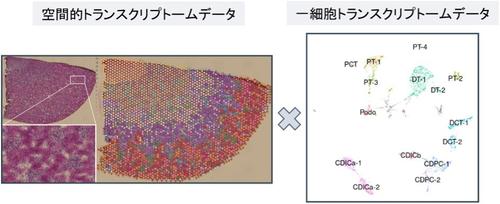2022-04-24 シンガポール国立大学(NUS)
 This image shows the ISM1 protein (in green) produced by alveolar macrophages (AMs) (red), which show up in this image via double immunofluorescence staining. Yellow represents the presence of both the ISM1 protein and AM in the same location, with blue representing the nucleus of a cell. Within the human body, ISM1 is found in the largest quantities in the lungs.
This image shows the ISM1 protein (in green) produced by alveolar macrophages (AMs) (red), which show up in this image via double immunofluorescence staining. Yellow represents the presence of both the ISM1 protein and AM in the same location, with blue representing the nucleus of a cell. Within the human body, ISM1 is found in the largest quantities in the lungs.
この研究は、NUS Biological SciencesのGe Ruowen准教授が主導し、2022年1月に権威ある科学雑誌「Proceedings of the National Academy of Sciences(PNAS)」に掲載されました。
<関連情報>
- https://news.nus.edu.sg/nus-scientists-discover-promising-biologic-drug-for-treating-chronic-lung-disease/
- https://www.pnas.org/doi/10.1073/pnas.2019161119
ISM1は細胞表面GRP78を介した肺胞マクロファージのアポトーシスを介して肺のホメオスタシスを保護する ISM1 protects lung homeostasis via cell-surface GRP78-mediated alveolar macrophage apoptosis
Terence Y. W. Lam, Ngan Nguyen, Hong Yong Peh, Mahalakshmi Shanmugasundaram, Ritu Chandna, Jong Huat Tee, Chee Bing Ong, Md. Zakir Hossain, Shruthi Venugopal, Tianyi Zhang, Simin Xu, Tao Qiu, Wan Ting Kong, Svetoslav Chakarov, Supriya Srivastava, Wupeng Liao, Jin-Soo Kim, Ming Teh, Florent Ginhoux , W. S. Fred Wong , and Ruowen Ge
Proceedings of the National Academy of Sciences Published:January 19, 2022
DOI:https://doi.org/10.1073/pnas.2019161119
Abstract
Alveolar macrophages (AMs) are critical for lung immune defense and homeostasis. They are orchestrators of chronic obstructive pulmonary disease (COPD), with their number significantly increased and functions altered in COPD. However, it is unclear how AM number and function are controlled in a healthy lung and if changes in AMs without environmental assault are sufficient to trigger lung inflammation and COPD. We report here that absence of isthmin 1 (ISM1) in mice (Ism1-/-) leads to increase in both AM number and functional heterogeneity, with enduring lung inflammation, progressive emphysema, and significant lung function decline, phenotypes similar to human COPD. We reveal that ISM1 is a lung resident anti-inflammatory protein that selectively triggers the apoptosis of AMs that harbor high levels of its receptor cell-surface GRP78 (csGRP78). csGRP78 is present at a heterogeneous level in the AMs of a healthy lung, but csGRP78high AMs are expanded in Ism1-/- mice, cigarette smoke (CS)-induced COPD mice, and human COPD lung, making these cells the prime targets of ISM1-mediated apoptosis. We show that csGRP78high AMs mostly express MMP-12, hence proinflammatory. Intratracheal delivery of recombinant ISM1 (rISM1) depleted csGRP78high AMs in both Ism1-/- and CS-induced COPD mice, blocked emphysema development, and preserved lung function. Consistently, ISM1 expression in human lungs positively correlates with AM apoptosis, suggesting similar function of ISM1–csGRP78 in human lungs. Our findings reveal that AM apoptosis regulation is an important physiological mechanism for maintaining lung homeostasis and demonstrate the potential of pulmonary-delivered rISM1 to target csGRP78 as a therapeutic strategy for COPD.


